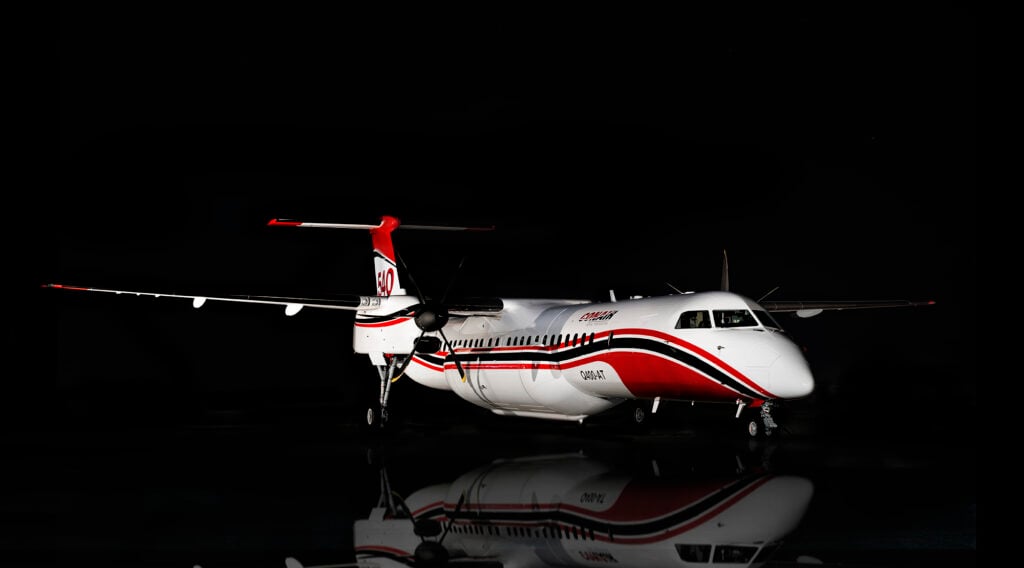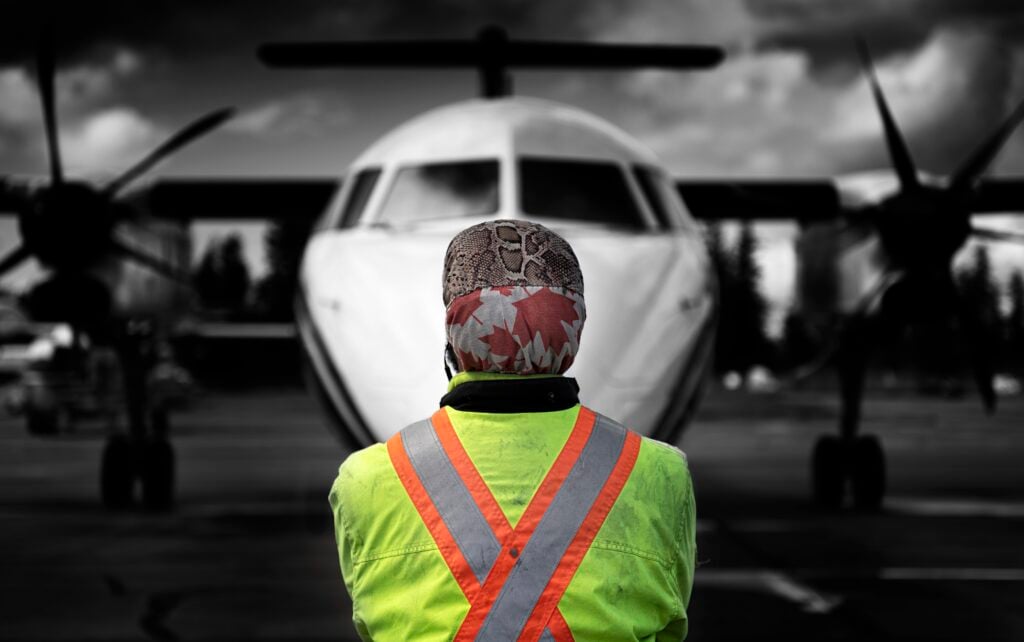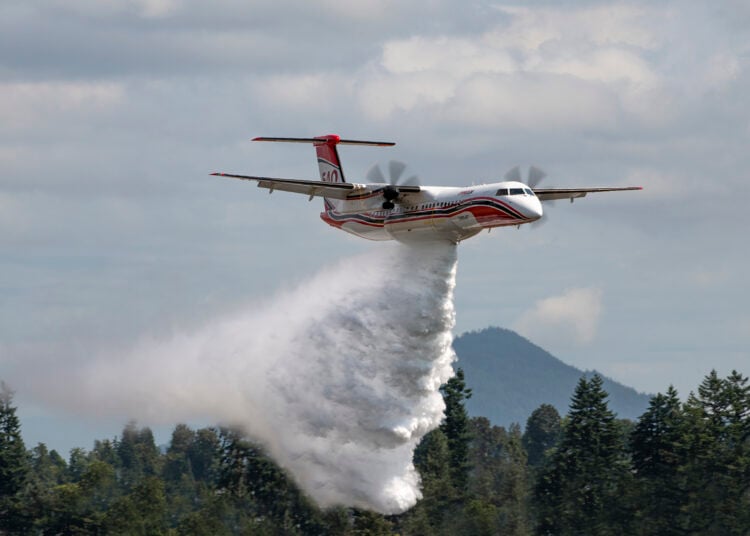During the 2021 fire season, while Canada and the U.S. developed plans around having access to their combined resources, Mother Nature threw a curveball this season, keeping each country’s resources at home trying to deal with domestic wildfires. Officials across both borders, and into Mexico, have issued strong warnings about the potentially catastrophic fire conditions that may well be the new normal, with major drought conditions across the continent.
Given that airtanker fleets worldwide continue to age, set amidst a global increase in wildfires, Conair set out to find a solution that would provide a modern aircraft that would see the company’s operations thrive decades into the future. Conair’s Dash 8-400 Airtanker was designed to provide a "Next Gen" aircraft suitable for operations worldwide. Already in service, the “Q”, as it has been nicknamed, has proven itself to be a dependable platform for successful air attack operations for operators large and small. Versatility was a key element in the overall planning and design process from square one.

In response to those grim statistics, the process that brought the Dash 8-400AT from inception to operational status was the result of an extensive evaluation process in the search for a ‘next gen’ aerial attack aircraft. Jeff Berry, Director, Business Development for Conair, highlighted that process during an interview with AerialFire.
“Conair originally considered dozens of potential aircraft platforms before narrowing down the shortlist. We performed an in-depth analysis of the Dash 8-400 in production to evaluate the suitability of the aircraft for airtanker conversion while still meeting the established performance expectations of the customer. Flight operations concluded it had superior low-speed maneuverability, especially in rugged terrain, with the power and speed to execute missions. Our maintenance team concluded its strong operational history indicated the aircraft wasn’t prone to service difficulties and was in ready supply of parts, meaning it would be operational for dispatch when needed most. Our engineers concluded that although the aircraft’s primary role is a passenger-carrying airliner, the airframe’s design allowed for growth into alternative roles, including aerial firefighting with an externally mounted tank, and emergency response services including freight or medical evacuation capability. The strength of the aircraft provided an ideal platform for airtanker conversion incorporating the innovative tank design produced by Conair engineers with support from Bombardier/De Havilland. Adding to its long list of benefits is that the aircraft is also fuel-efficient, burning far less fuel for payload delivered than other similar size air tankers.”

International Roots
Conair has been in the firefighting business for over 50 years. Based in Abbotsford, British Columbia, the company started out small with a handful of employees and less than two dozen aircraft. Today, its current fleet numbers over 70 aircraft and nearly 400 staff, including 100 pilots. Adding to that fleet from 2021 forward will be nearly a dozen Dash 8-400ATs.
The current Dash 8-400AT has its roots in a 2004 contract from France’s Ministère de l’Intérieur Direction générale de la sécurité civile et de la gestion des crises (DGSCGC) to develop a multirole aircraft that could not only carry fire retardant but could be easily reconfigured for passengers, medevac, cargo, or combi roles. The result was designated the Dash 8-400MRE, known as the Fireguard. It was the result of Conair modifying and reconfiguring existing commuter aircraft and adding an external retardant tank that could easily be removed or installed as the role dictated. Two were delivered in 2006 with six more being ordered, the first delivered in 2019. The Dash 8-400AT shares that direct lineage with the Fireguard, both fitted with an external 10,000 liter (2,642 US gallons) retardant tank.
2019 – A Year of Change
The global statistics on wildfires have indeed been grim the last number of years, in light of that, Conair made the decision in 2019 to develop and market a new generation airtanker that would provide a technically sophisticated, high-performance platform that would address the coming global shortfall in aerial firefighting fleet capacity.
The work began on two Dash 8-400s already in the commercial passenger/cargo role, first by removing all unnecessary interior equipment for a major reduction in weight. The goal was to provide an aircraft that fully met U.S. Forest Service Type 2 requirements of 1800 – 2999 U.S. gallon capacity.
High performance was a key element in the design process. One of the biggest advantages of the Dash 8-400AT is its excellent STOL/short-field performance, with the ability to operate comfortably from 5,000-foot airstrips. This provides agencies with a cost-effective option to replace or supplement existing Type 1 and 2 airtankers. That performance is in large part due to the Pratt & Whitney Canada PW150A turboprops rated at over 5057 shaft horsepower that provides excellent thrust ratings even at high-density altitudes.
Another big plus of the Q is its external tank configuration, which means the aircraft remains pressurized, with a full climate control system that greatly enhances crew safety and comfort.
Modern Cockpit Design
The Q features an advanced tank control system, situated on the central instrument panel for easy access by both pilots. As well, the aircraft comes with a Conair developed, Transport Canada certified, Flight Envelope Awareness System (FEAS) providing a wide range of safety awareness information such as instantaneous G-Loading, slow speed awareness, angle of attack detail, and flap configuration over-speed awareness. The FEAS system puts critical information into the pilot’s field of view, enabling them to stay in the safe zone and minimize exposure of the aircraft to high-risk excursions outside of the flight envelope. The system prevents exceedances, preserves the structural integrity of the aircraft, and extends the life of the airframe. An advanced GPS navigation suite comes standard, with a heads-up display option available as required.
Economy of Operation
In this era of decreasing budgets with expanding operational needs, the Dash 8-400AT provides significantly lower operating costs than typical Type 1 airtankers. It can carry almost 90 percent of the load of larger aircraft, but with a fuel consumption reduction of 50 percent or more.
Optimum Fleet Mix
The overall approach to a world with an increasing number of wildfires has placed the focus on achieving an optimum fleet mix in terms of both size, and the capability to deliver water or retardant loads as the specific situation demands. Water loads – whether alone, with foam or gel – can have immediate but unfortunately short-lived suppression actions. Retardant not only slows combustion, but its effects are immediate and long-lasting. Both are essential parts of a comprehensive response to reducing the damage from wildfires.
Going Green
Conair has been proactive in responding to this new reality, and the Dash 8-400AT is no exception. Incorporating the latest in turboprop technology and advanced aerodynamic design directly contribute to lower emissions, lower fuel burn, and a lower noise footprint when compared to existing airtankers of similar load capacity.
International Markets
There is a current gap worldwide in tanker fleets between existing fleet configurations. In the U.S. Type 2 Neptune aircraft have been retired, leaving a fleet of Type 1 and Type 3 tankers, with a subsequent gap between the two.
“The Dash 8-400AT provides the perfect compliment for agencies operating primarily water scooping aircraft, who seek to balance their approach by introducing retardant to their operations.” Jeff Berry noted. “While water cools the flames, retardant slows combustion. Retardant lines the perimeter of the fires, slowing its progression, while water drenches the interior, cooling its heat. Using both amphibious airtankers with retardant tankers on a fire, working in concert with each other, offers a one-two punch to fight the extreme wildfires of today. The Dash 8-400AT also fills a gap in all markets whose agencies do not have numerous large airports to support large airtanker operations. The Q can be positioned in remote locations, closer to where fires break out, operating on shorter runways. Mobile tanker services including fuel and retardant can be set up to make nearly any appropriate runway operational for aerial firefighting services. And the tanker is a reliable, long-term investment, a strong aircraft that will keep flying for decades, as exhibited in France who is entering their 17th year in operation with no end in sight.”
Features and Performance

- An external 10,000 liter / 2,642 gallon tank with a proprietary Retardant Delivery System (RDS), capable of multiple, constant-flow coverage levels from a single, controlled-flow drop over wildfires
- The most advanced constant-flow RDS in the world – a new generation Conair/Moog M3000 controller system providing enhanced flow capability for lower volume drops, reduced volume repeatability range as low as 2%, performance data capture, recording, and diagnostic analysis capability
- Holder of 3 ‘Time to Climb records - a fast dispatch reducing the time from base to fire and return
- A specialized Flight Envelope Awareness System providing enhanced safety data including slow speed and angle of attack detail
- A mission duration of 3.5 hours (including reserve)
- Cruise speed of 360 knots (667 km/h)
- Maximum operating altitude 25,000 ft (7,600 m)






